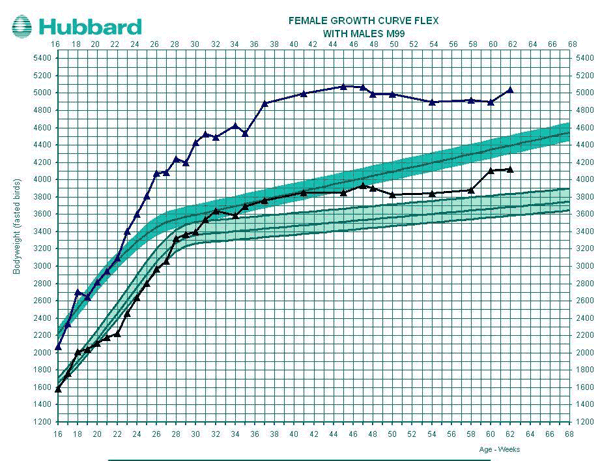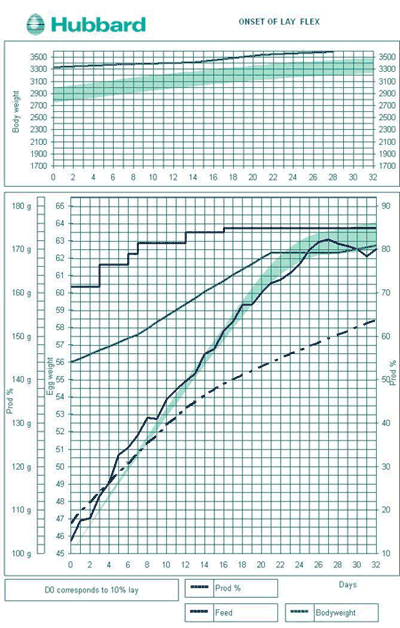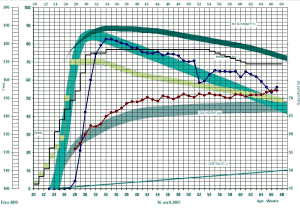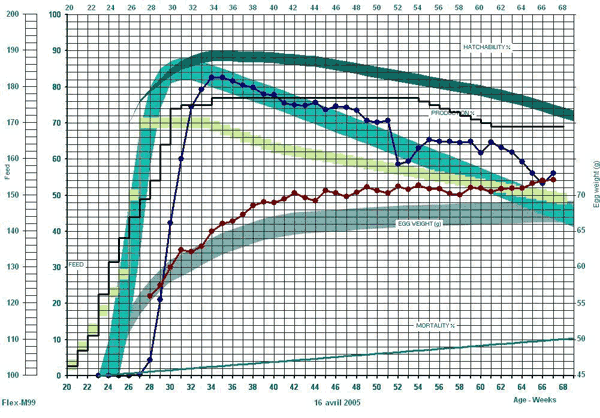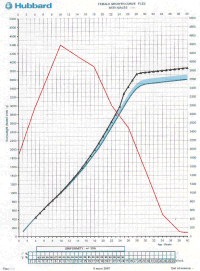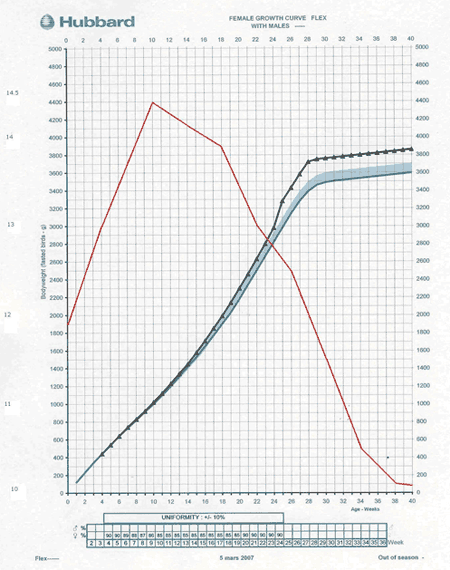



Management of “out of season” broiler breeder hatches in open-sided housing in areas of the world at and above 30º from the equator.
By Dr. Patricio Liberona DVM, Alastair Lewin NDP. Technical Services, Hubbard Breeders.Introduction:
This presentation is intended to cover a very particular situation in broiler breeder management, encountered frequently in areas of the world at high latitude (latitude 30° and beyond - North and South from the Equator) … and additionally for breeder flocks placed in the narrow "out of season" period of the year (March / April in the Northern hemisphere and September / October in the Southern Hemisphere).
Many flocks in these areas and placed during this period fail to perform properly in egg production due to the challenging conditions of synchronizing body condition, light stimulation and feeding for peak and persistence, when increasing and decreasing natural daylength pattern caught the pullets at critical time of their rearing for optimal sexual maturity and light control in the rearing house is not available or inadequate.
It is important to note that these management tips are NOT intended to apply to flocks placed in other areas of the world and on different periods of the year.
Many farms still use open-side housing and their flocks are subjected to some difficult to control conditions during important key periods of pullet development…This frequently affects them at the wrong moment!
What should be done for the specific "out of season" (March / April hatched flocks -Northern hemisphere and September / October hatched flocks - Southern hemisphere) to obtain satisfactory "on time" production when using open-side housing? Late February and May hatches (Northern hemisphere and late August and November hatches - Southern hemisphere) are also considered "out of season", but generally are not as difficult to manage.
This article is intended to assist in managing flocks in open-sided housing to achieve improved technical results, albeit not as good as, with fully controlled housing.
These difficult "out of season" flocks are affected by:
- A long period of increasing natural daylength and strong light intensity followed by stable daylength and decreasing light intensity during their pre-puberal period, prior to stimulation. The longest day of the year is June 21st and December 21st in the Northern and Southern hemispheres respectively and these hatches are caught between 8 and 17 weeks of age, when the natural daylight switches from increasing to decreasing
- Extreme heat and often poor water and feed quality, at the moment that the growing pullets should be gaining bodyweight and improving uniformity for fleshing » Clostridia and sub-clinical Coccidiosis may also affect litter conditions and flock health
- High fly populations » worm infestation is increased » intestinal disturbance
- Aggressive males » stress » enteritis » peritonitis » low peak followed by death
- Insufficient evaluation of weekly weight gain and fleshing uniformity
- Choose the appropriate bodyweight growth curve, and manage the flock to assure weekly bodyweight gain and uniformity for fleshing. At this latitude labour is generally abundant, so this should not be difficult. Manage the above factors that will affect bodyweight gain and uniformity.
- Determine the best way to assure that the flock perceives a difference between the actual light duration and light intensity and what is available for stimulation.
1. Bodyweight and uniformity:
The way that the bird is grown up to 10 weeks does not need to be different for any season or type of house. However, what happens between 10-16; 16-20; 20-24 and 24-28 weeks is important and uniformity of fleshing is critical. It has been demonstrated with regular sized meat breeders in cages that excellent results can be obtained, because the birds can be easily graded by fleshing. The flock is then fed accordingly for continued growth and later for production!
- Up to 10 weeks the skeleton is being developed. Some managers' stay exactly on the target and others rear them slightly higher at 4-6 weeks and then bring them back to the target for 10 weeks. Satisfactory results can be obtained with both methods.
- Between 10-16 weeks is the period of the "reversed S" growth curve, where the flock is held as tight as possible to the lower side of the curve. Available feed equipment and feed density must be considered, as these factors affect eating behaviour. Relax the severity of restriction and stop at 14 weeks if the eating behaviour is poor. Uniformity must be excellent during this period. Hubbard genetics makes this easy, especially with the use of the 5/7 feed day programme.
- Between 16-20 weeks % weight gain is the key point. At 16 weeks re-grade the flock by fleshing into 3 groups and then re-weigh each separate group and apply a 35% weight gain. This becomes the target bodyweight at 20 weeks. Take a "mid-week" weight sample and adjust feed accordingly.
- Between 20-24 weeks weight gain should be 160 g weekly or a further 30% gain and uniformity should again improve. Stay on the 6/7 days feed programme from 154 days until 5% daily production, which should help uniformity. Some may argue that this can add to any delay in production. Balance this against the risk of poor uniformity, incorrect feeding to peak and then unnecessary fattening of the flock. A mid-week sample weight is useful to assure correct feeding of the flock. Birds that look physically immature, as late as 24 weeks can be removed to an appropriate bodyweight group, where they can be fed correctly.
- Between 25-28 weeks is the period when many flocks fail to gain weight correctly, because birds are often weighed in the afternoon, which includes feed and water; following the same bodyweight curve effectively means that no weight gain was made. In this period either deduct 150 g from the average pen bodyweight or add 150 g to the target weight. Making the graph 150 g heavier creates a graph that looks strange, but the flocks that perform follow this type of curve. These birds are NOT OVERWEIGHT, but are correctly fleshed for the season.
Nutrition during the hot season 16-24 weeks:
An improved grower ration (grower II) from 16 weeks would be beneficial.- Increase energy 50-100 kcals over the grower feed level, when using low energy rations (less than 2800 kcals/kg)
- Increase Lysine to 0.80%
- Increase vitamins 10%
- Unless the feather growth is poor do not increase Methionine.
- The pre-breeder ration can start at 141 days and continue until about 5% daily production.
Production:
When production does not increase fast it is not good to be pushing the flock with feed. Generally when the uniformity for bodyweight and fleshing is correct and the flock is correctly light stimulated, the production should increase adequately, but slower than what would normally is observed with "in season" flocks.
Egg size:
Hubbard genetics inherently has good egg size from the start. The natural delay in maturity of "off season" flocks reared in open-side housing, when followed by high linoleic acid and methionine levels in breeder rations may increase this unnecessarily. Therefore, when rearing weight gains have been difficult to achieve, lysine can be increased to 0.80%, however methionine can be maintained at 0.36% in the grower ration. It is also advisable not to change to pre-breeder ration before 140 days.
Feeding the flock for production:
Change to breeder at around 5-10% daily production; too early and the immature birds consume too much minerals and will suffer metabolic problems.
The flock will probably be eating 140-145 g feed when it is at 5% daily production in order to have the required bodyweight. This leaves about 30-35 g available for pushing feed increases to peak production. If the bodyweight is as shown in the previous example the amount left for production should be sufficient. Use the "onset of lay" sheet and follow production and egg weight daily. Twice weekly bodyweight is better than weekly weighing from during the 6 weeks that usually takes from 10% to peak production. If they eat sufficient the results should follow or better the standards set. Increase in bodyweight » production increases.
The above flock when it finally achieved around 3700 g was able to perform adequately.
Flushing the flock:
The flock can be "flushed" through the water system just prior to stimulation:- 5 days of calcium and phosphorus at prescribed levels
- 2-3 days of multivitamins and vitamin E at prescribed levels
2. Light stimulation:
Some key housing adaptions can help these difficult "off season" flocks tremendously when devising a plan that helps the pullets to perceive better the light stimulation.- The design of the house:
- House height. Multi-story houses; the higher the house and single story houses the higher the eves/apex » the stronger is the inside natural light
- Window size to floor area. At this latitude this is generally around 30% to allow for some form of ventilation » high inside natural light intensity
- House orientation East-West has benefits, as it reduces the concentration of heat on the roof and also the light intensity that enters the house.
- Roof overhang suitable to hang "orchid netting" to reduce the light intensity entering the house and allow for some form of ventilation?
- Shade for the direct sunlight (trees, bushes) and cover for the surrounding ground area to reduce reflection
- House ventilation capability? No ventilation makes it difficult to use orchid netting.
- Light layout:
- Number of rows, distance between lights and type of lights
- Type and capacity of light source (warm red spectrum, daylight, cool white light, sodium, mercury) incandescent; energy saver; tubes. Cool white light does not give the correct light spectrum.
- Light reflectors, bright ceiling to push the light down to bird eye level.
- Position lights for reflectivity. Fixed on the side walls only lights up the ceiling!
- The lights:
- 2-3 rows is not sufficient » needs 4-5 rows
- Not all lights should be used during rearing » individual control on each row
- Ability to increase light intensity as the flock becomes older and have at least 25% more intensity than for 'in season" flocks at the time of stimulation
- Light intensity is measured at bird eye level and must be uniform.
A reminder of the basic principals for successful light stimulation:
- The correct level of physiological development at the time of stimulation
- Birds differentiate night and day due to the effect of light stimulating the hypothalamus in the brain
- Light energy (red / orange colour range) stimulates the pituitary gland
- Birds are stimulated by;
- The initial "lights on" dawn
- The 11-13 hours after this is the most important (photosensitive period).
- Light intensity for production should increase about 10 X that of the rearing period
- Light intensity during production should not be less than rearing and be capable to reduce the effect of the bird seeing the decreasing natural intensity after July in the Northern hemisphere and January in the Southern hemisphere
How much sunlight enters the house at the peak of the day after the flock is 12 weeks of age? If this can be controlled during the rearing period to as low as possible, the chance of reasonable stimulation is enhanced. This is why flocks being stimulated in October to January should not have any problems if part 1 has been accomplished properly and there is sufficient increase in light intensity.
Practical ways to reduce the effect of strong natural light intensity:
- Taking great care, it is possible to use orchid netting on the side window to reduce the amount of light entering the house and at the same time allowing fresh air to enter. Black colour is best; blue during rearing must be removed at the time of first light stimulation. Blue colour delays sexual maturity!
- Control the curtains on each side of the house to provide ventilation and to reduce the amount of light intensity entering the house.
Practical ways to increase perceived light intensity:
- Keep the walls dark during the rearing (difficult when caustic soda is used as a disinfectant and walls are white-washed)!
- In case pullets are not transferred to laying quarters at housing and are kept in the same house, all their lives, in some countries, just prior to light stimulation they paint the inside of the house with white-wash. This is done effectively in some countries.
- Clean the lights and light fittings. Where necessary repaint the tube or ceramic holders with bright white or aluminium paint.
- Use aluminium "pie plates" to deflect the light down.
- Lower the height of the light fittings to 1.80 m to be closer to the birds.
- Increase the number of lights using sodium or incandescent lights.
What is happening to the naturally increasing or decreasing daylight?
- Up to 21 weeks?
- Up to 30 weeks?
- After 40 weeks? This is very important to help to improve persistency, if a plan is made before the light stimulation starts!
Visualise bodyweight and the natural daylight trend together:
- March and April flocks (N.H) are subjected to decreasing natural day-length, as they come into production.
- In the Northern hemisphere, and after June 21st, day-length starts to decrease by about ½ hour to approximately 14 hours. Light intensity also diminishes somewhat. This happens after December 21st in the Southern hemisphere.
- These March / April (N.H.) and September / October (S.H) hatches can be reared under natural day-length during their first 10 weeks of age. After that age, light intensity should be kept as low as possible, with dark curtains and/or "orchid net". In fact, these flocks benefit if subjected to low light intensity from as early as 2 - 3 weeks. Special attention must be paid to assure good ventilation.
- From 10 weeks of age to the moment of light stimulation, implement a constant day-length equal to the longest day-length for the period (approx. 14 hours), minus 1 hour.
- Use of extra artificial light will be required. During this period (10 - 20 wks) day-length inside the house should end 1 hour before the natural day ends. If the house is dark enough, the birds may be fooled to perceive the day is 13 hrs instead of 14 hrs. The extra hours of artificial light to be added during rearing (approx. 2 hours) are given at sunrise for 1 hour and then 1 hour to end 13 hours later, to acclimatise the flock to "on / off" artificial lights.
- Advance body weight target in 1 week; 20 weeks weight at 19 weeks of age. High uniformity in both, body weights and fleshing are a must at 140 days of age.
- At 141 days, increase total day-length to 17 hours. Maintain strong and uniform light intensity at bird level using warm red light spectrum. Use 160 w sodium lights or 150 w incandescent. Do not use cool white type of lights.
In this difficult "off season", meat breeder flocks will have difficulty to peak until they have a uniform bodyweight of around 3700 g including feed and water. Mini breeds will also have a higher weight relative to their standard.
Cumulative individual bird energy consumption especially from 16 - 24 weeks is important. If the flock is in a deficit position 24 weeks, it will use feed energy to finish preparing the body, which can be another reason for delayed maturity therefore, eating behaviour is very important.
SHORT CUTS TO BOTH CHICKEN AND LIGHT MANAGEMENT TO SAVE MONEY COSTS MONEY!








